Of
late, there has been a lot of discussion about the
relative performance of the states in India. A spate
of analyses has been devoted to considering the growth
performance of the different states, and many of the
traditional prejudices regarding the ‘dynamic’ and
‘stagnant’ regions seem to be confirmed by such analyses.
These patterns are then explained by the usual arguments
with respect to backward and forward states. During
the 1990s, it has further been argued that those states
that have been more open to economic liberalization
have shown faster rates of growth in general.
However, much of such analysis has been in terms of
aggregate growth rates, whereas obviously what is
more significant is the change in per capita income.
It is well known that regional inequalities are large
in India, and there is widespread perception that
they have increased in the recent past. Chart 1 indicates
the relative position of states with respect to aggregate
net State Domestic Product (SDP) and per capita net
SDP in 2000–01 (at constant 1993–94 prices). The importance
of considering per capita patterns becomes immediately
obvious from this chart. Among the largest economies
in terms of aggregate SDP, only Maharashtra is among
the top in terms of per capita income. Uttar Pradesh,
the second largest state economy in aggregate terms,
is among the lowest in per capita terms. Meanwhile,
Punjab and Haryana, which have relatively small total
SDP, have the highest and third highest per capita
incomes.
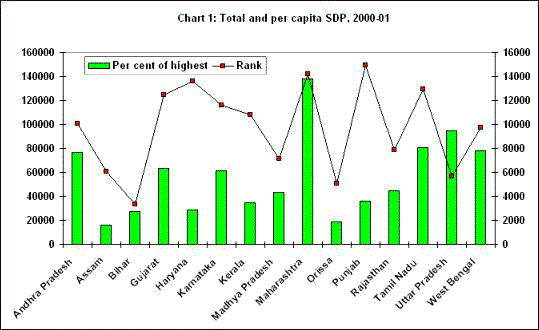
Chart
1 >> Click
to Enlarge
Of course, all this says nothing about intra-state
inequalities, which also cannot be assumed to be similar
across states. The NSS estimates show that some of
the states with highest per capita income have also
the highest internal inequalities in terms of per
capita consumption expenditure. Thus, the two states
with the highest Gini coefficients for per capita
consumption (indicating the greatest inequality) are
Tamil Nadu (with a Gini ratio of 0.398 in 1999–2000)
and Maharashtra (with a Gini ratio of 0.345). These
two states are among the highest in per capita SDP.
However, other states with high per capita SDP show
relatively less inequality in consumption expenditure.
Thus Punjab showed a Gini coefficient of 0.29, while
Haryana had a Gini ratio of 0.285 in the same period,
for per capita consumption expenditure. Conversely,
some states with low per capita SDP such as Uttar
Pradesh and Bihar had relatively high inequality with
a Gini ratio of 0.327 and 0.318 respectively.
In what follows, we will ignore intra-state income
inequalities, and focus on patterns across states,
in terms of per capita income and growth. We will
also ignore rural–urban differentials within states,
which are also estimated to have increased over time
and especially in the last decade.
Charts 2 to 5 show the per capita SDP of each state
as per cent of the highest (which in all of the years
happens to be Punjab) and the rank of the various
states in the four years 1970–71, 1980–81, 1990–91
and 2000–01. A comparative look at these charts reveals
a number of interesting trends.
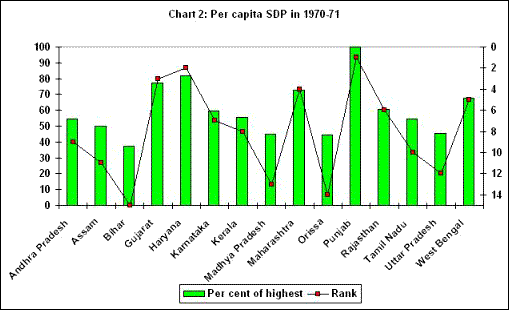
Chart
2 >> Click
to Enlarge
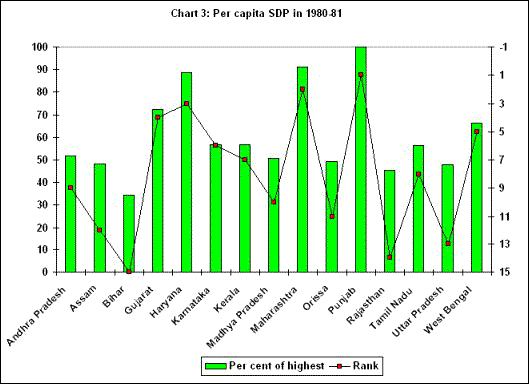
Chart
3 >> Click
to Enlarge

Chart
4 >> Click
to Enlarge
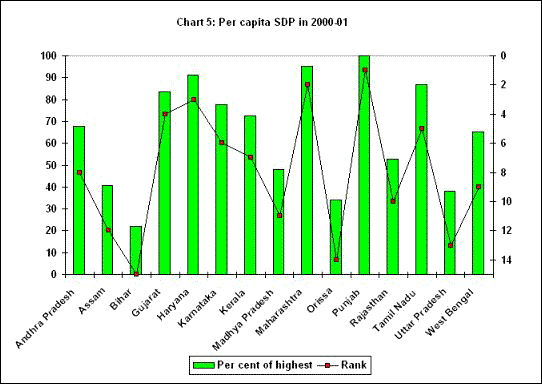
Chart
5 >> Click
to Enlarge
First, it emerges that over time the basic hierarchy
has broadly remained the same, with Punjab, Haryana
and Maharashtra at the top in per capita terms, and
Bihar and Orissa at the bottom. Within this, however,
a number of the states with relatively higher per
capita income have been improving their position vis-ŕ-vis
the state with the highest, which is Punjab. This
was especially true for the period 2000–01, when there
were four states (Haryana, Maharashtra, Tamil Nadu
and Gujarat) with per capita incomes of more than
80 per cent of that of Punjab, compared to 1970–71,
when only the state of Haryana could cross that mark.
In other words, as compared to the earlier years,
at present there is less difference among states at
the top in terms of per capita incomes.
Another feature that emerges is the variation in the
relative position of the ‘middle income’ states vis-ŕ-vis
the highest, not only in terms of ranking, but as
proportions of the highest per capita SDP. States
such as Tamil Nadu, Karnataka and Kerala show significant
increases over the longer period, with some fluctuations
in 1990–91. Andhra Pradesh shows wide fluctuations
with an increase in 2000–01, while West Bengal shows
no clear trend, despite a dip in 1990–91 and a recovery
thereafter.
Finally, the deterioration of the relative position
of the lowest per capita income states, is worth noting.
In the 1970s and 1980s, Orissa and Bihar (the two
states with the lowest per capita SDP) had per capita
incomes between 40 to 50 per cent of that of Punjab;
by 2000–01, the figures had fallen to 34 per cent
for Orissa and only 22 per cent for Bihar. In other
words, in some of the more backward states, the disadvantages
of the low base combined with other factors create
relative stagnation in per capita incomes, thus increasing
gaps with the richer states.
This phenomenon of increasing gaps between richest
and poorest states is shown very clearly in Chart
6 that describes the per capita SDP of the richest
state (Punjab) as a multiple of the poorest (Bihar).
It shows that the divergence increased even in the
period 1970–90, but not very substantially, and in
1990–91, the ratio was just above 3 times. But over
the 1990s there was an explosive increase in such
inequality that caused the gap to increase dramatically
to more than 4.5 times by 2000–01.
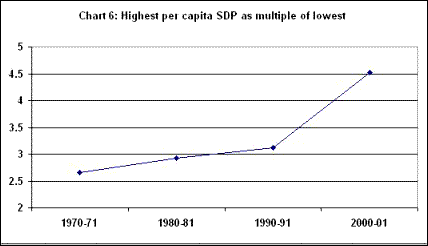
Chart
6 >> Click
to Enlarge
Clearly, the causes for such increasing divergence
over the most recent period require further investigation.
Some possible causes and factors are discussed below.
But before that, it may be worth looking into the
patterns of growth of aggregate SDP, to see if there
are any trends that emerge from such overall performance.
Chart 7 indicates that there has been no such thing
as a common pattern across states in terms of SDP
growth rates, and also that the trends have varied
widely across decades. While it is true that some
of the more ‘backward’ states exhibit lower rates
of growth, this has not been consistently true over
all three decades. Thus, in the 1980s, several of
the supposedly ‘BIMARU’ states (Bihar, Madhya Pradesh,
Rajasthan and Uttar Pradesh) grew faster than the
national average in terms of aggregate SDP, thereby
providing challenges to the more common perception.
By the 1990s, however, growth had decelerated in these
states (except Rajasthan), but so also did it slow
down in a number of the higher income states such
as Maharashtra, Punjab and Haryana.
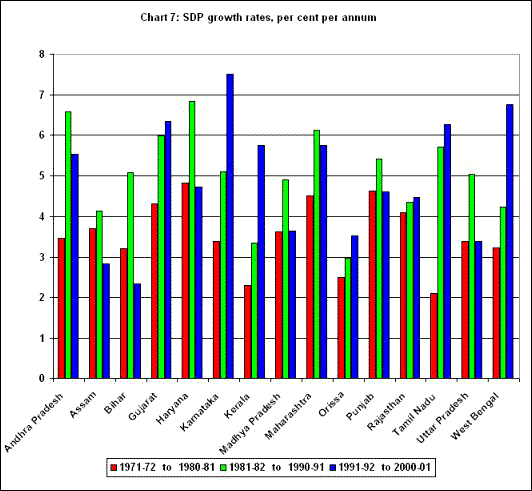
Chart
7 >> Click
to Enlarge
Interestingly, in the 1990s, West Bengal showed the
highest rate of aggregate SDP growth after Karnataka,
even though it has not been generally recognized as
a fast growing state. Indeed, its aggregate rate of
growth appears to have been faster than that of Gujarat
and Tamil Nadu, both of which are described as dynamic
states. This comes out even more sharply in terms
of per capita incomes. Chart 8 gives some indication
of the aggregate rates of growth and per capita SDP
in the second half of the 1990s, for the six largest
state economies. Karnataka clearly grew at the fastest
rate, in both aggregate and per capita terms, followed
by West Bengal and Tamil Nadu.
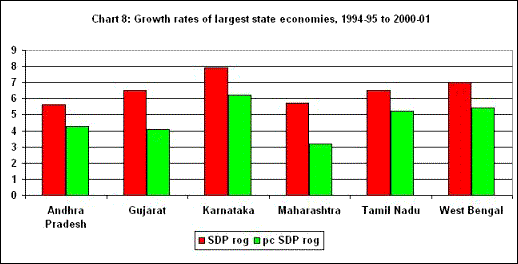
Chart
8 >> Click
to Enlarge
The
gap between West Bengal and Tamil Nadu, on the one
hand, and Gujarat and Andhra Pradesh on the other
hand, was significantly greater in terms of per capita
growth, than in aggregate SDP growth. This is possibly
reflective of the greater success of West Bengal and
Tamil Nadu in controlling fertility and therefore
also population growth. But once again, these patterns
are not generally recognized.

